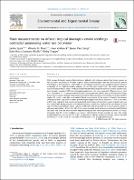| dc.contributor.author | Epila, Jackie | |
| dc.contributor.author | Maesa, Wouter H. | |
| dc.contributor.author | Verbeeck, Hans | |
| dc.contributor.author | Campa, Janne Van | |
| dc.contributor.author | Okullod, John Bosco Lamoris | |
| dc.contributor.author | Steppe, Kathy | |
| dc.date.accessioned | 2020-07-25T07:52:06Z | |
| dc.date.available | 2020-07-25T07:52:06Z | |
| dc.date.issued | 2017 | |
| dc.identifier.citation | Epila, J., Maes, W. H., Verbeeck, H., Van Camp, J., Okullo, J. B. L., & Steppe, K. (2017). Plant measurements on African tropical Maesopsis eminii seedlings contradict pioneering water use behaviour. Environmental and Experimental Botany, 135, 27-37. | en_US |
| dc.identifier.uri | https://hdl.handle.net/123456789/123 | |
| dc.description.abstract | With increased drought events affecting forests globally, little is known about their future impact on
Africa’s forests. In particular, we need to gain a better understanding of how key African forest species
will respond to drought stress. In this study, we investigated functional traits and physiological responses
to drought of the light-demanding pioneer species Maesopsis eminii Engl. The study involved an
experiment on potted M. eminii seedlings with three different drought treatments in which sap
flow (SF),
stem diameter variation (SDV) and stomatal conductance (gs) were measured. Whereas low gs rates
(39
30 mmol m 2 s 1) and pronounced SF-VPD (vapour pressure deficit) and gs-VPD hysteresis loops
during well-watered conditions indicated conservative stomatal control on water loss, nocturnal sap
flow
implied M. eminii is not able to completely block transpiration. At the onset of drought, the pioneer
seedlings retained high stem diameter growth despite highly reduced soil moisture (> 0.95
0.03 MPa)
and SF rates, indicating that growth was prioritised. Contribution of stored stem water to daily water use
was limited both during drought and control conditions, which was confirmed by the absence of time
lags between photosynthetic active radiation (PAR)-SDV, PAR-SF and SDV-SF in all treatments. Below a
soil water potential of
0.95
0.03 MPa, leaves were gradually shed, but diurnal and nocturnal SF did not
turn zero, and absolute stem diameter kept decreasing for the entire experimental period (115 days),
portraying that M. eminii seedlings can survive only limited drought periods. In sum, this study
demonstrated that species-specific traits, as opposed to species ecological strategy, govern drought
performance. For M. eminii, its leaf traits proved pivotal to its drought performance. | en_US |
| dc.language.iso | en | en_US |
| dc.publisher | Environmental and Experimental Botany | en_US |
| dc.subject | Internally stored water | en_US |
| dc.subject | Hysteresis | en_US |
| dc.subject | Time lag | en_US |
| dc.subject | Stem diameter variations | en_US |
| dc.subject | Nocturnal sap flow | en_US |
| dc.subject | Water stress | en_US |
| dc.title | Plant measurements on African tropical Maesopsis eminii seedlings contradict pioneering water use behaviour | en_US |
| dc.type | Article | en_US |

